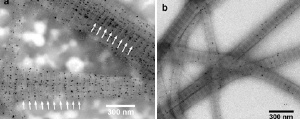Aug 16 2008
Collagen, the body's most abundant protein, serves as a natural scaffold for cells and directs when and where they will grow. Researchers at the Institute for NanoBioTechnology at Johns Hopkins University are discovering new properties and uses for a synthetic molecule that mimics collagen. When used with nanoparticles, this molecule, called collagen mimetic peptide (CMP) could produce detailed images of tumors, detect deadly buildup in arteries, deliver drugs, and improve blood supply to implanted tissues. Several useful properties of CMP are described in a paper by S. Michael Yu, associate professor of materials science and engineering in the Whiting School of Engineering, and Martin Pomper, professor of radiology and oncology at the School of Medicine, and published in the journal Biomacromolecules (June 12, 2008). Both are INBT affiliated faculty members.
 Transmission electron micrographs of reconstituted type I collagen fiber from mouse tail tendon after incubation with gold nanoparticles. The white arrows indicate positions of nanoparticles on collagen fibers. Credit: AMS
Transmission electron micrographs of reconstituted type I collagen fiber from mouse tail tendon after incubation with gold nanoparticles. The white arrows indicate positions of nanoparticles on collagen fibers. Credit: AMS
“Collagen is a great house for a cell to grow, but there are places where you should not have collagen,” Yu says. “Tumors or blood clots that can lead to a stroke are primarily made of collagen.”
The research shows for the first time that synthetic collagen binds to natural collagen in an unpurified ex vivo state—that is, in unprocessed natural tissue specimens (The binding of CMP to purified and prepared collagen grown in a Petri dish was previously reported by Dr. Yu). CMP accomplishes this feat by weaving itself into collagen’s rope-like triple helical structure. The study also shows that CMP incorporates into collagen fibers at precise points along each strand.
“The collagen mimetic peptide was able to ‘sneak’ into the natural collagen fibers at regularly spaced intervals where the structure of collagen was more loosely bound,” Yu says. Using nanoparticles attached to the CMP molecules, the researchers were able to visualize the entry points with transmission electron microscopy. Each entry point appears as an evenly spaced row of black spots along the length of the collagen fiber, like the markings on a ruler.
To test the CMP’s ability to interact with natural collagen on an intact tissue sample, Yu and Pomper attached a molecule that would emit fluorescent light to the end of the synthetic collagen. Then, a solution of fluorescently tagged CMP molecules was used to stain a sample of human liver tissue. The brightly glowing CMP produced an image that was essentially identical to images achieved by staining with collagen-specific antibodies, the most commonly used method to image collagen, Yu says. “That tells us that in a natural system, the collagen mimetic peptide is binding only to the collagen and not to other proteins—and that has never been shown before.”
The tiny nano-sized CMPs also are able to produce images with greater resolution than antibodies, Yu says. “CMP can penetrate tissue that the antibodies, which are at least 20 times larger, cannot.” Better images give radiologists like Pomper the ability to see accumulations of collagen in places where it should not be.
Finally, the researchers observed that when the environment heats up—to around 37 degrees Celsius or body temperature—CMPs quickly lose their grip on natural collagen and are released. But by making the CMPs chains a little longer, the researchers could control the amount of time the synthetic collagen would remain bound to its natural counterpart. “The longer the chain, the longer CMP tended to stay in place,” Yu says. This property would allow CMP to be customized for therapeutic or diagnostic purposes—a short one for a quick dose and a long one to deliver a more sustained treatment.
Yu adds that the potential uses for collagen mimetic peptides are limited only by the types of molecules that one is able to attach to them, and he and Pomper have several patents pending on diagnostic or therapeutic applications. With nanoparticles or nanoshells attached, for example, functionalized CMPs could be used for imaging and drug delivery.
“One of the areas we’re working on now is targeted delivery of these functionalized CMPs,” says Pomper. “The key will be whether we can make them recognize the difference between normal collagen and pathological collagen.”
Synthetic collagen may also be able to improve the chances of survival for engineered tissue implants. Natural collagen contains chemical signals called growth factors that tell cells how and where to grow and direct the formation of blood vessels. Using growth factors that are linked to CMP, Yu is working on creating collagen scaffolds that can tell cells to form organized networks of blood vessels. A paper focused on this research will be published in the September online issue of Biomacromolecules.
But Yu knows that prospect is a long way off.
“Collagen is a very complicated system and we still don’t know a lot about it,” Yu says. “Using synthetic systems can give you a lot of information and are great for mechanistic studies of cell and scaffold interactions, but eventually many scientists come back to the natural scaffold that Nature has provided, the collagen, when they need to create artificial tissues.”
Collaborating on this work with Yu and Pomper were doctoral students Allen Y. Wang and Xia Mo, from the Department of Materials Science; instructor Catherine Foss, from the Department of Radiology; and master’s student Shirley Leong, from the Department of Chemical and Biomolecular Engineering. The work was funded by the National Institutes of Health and the National Science Foundation.